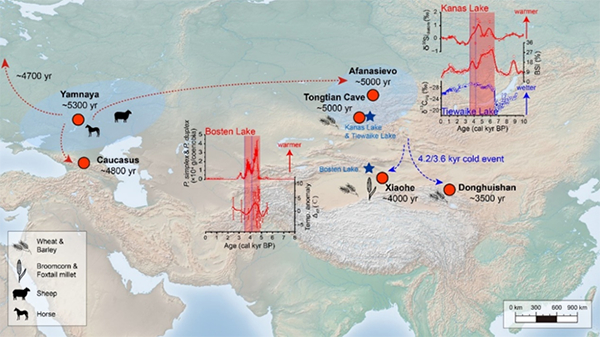Funded by the National Natural Science Foundation of China (Grant No.: 41991251, 41571182) and other programs, Professor Xiaozhong Huang's team of Lanzhou University and British collaborator (Associate Professor Virginia N. Panizzo) have made great progress in Holocene climate change on the prehistoric Eurasian Steppe Road. The research article titled as "Prehistorical population expansion in Central Asia promoted by the Altai Holocene Climatic Optimization" was published online by Nature Communications on May 29, 2023.
The Eurasian Steppe Road (ESR), as the major traffic of prehistorical ‘Silk Road’, has great significance for the exchange of earlier Eastern and Western civilizations. The Altai Mountains region is located at the core area of the ESR in central Asia. In the early Bronze Age, archaeological and genetic evidence shows that the Yamnaya people migrated from the southeastern European grasslands to southern Siberia and the western side of the Altai Mountains since about 5 ka (ka=1000 years ago), and developed into the regional Afanasievo culture. There were several hypotheses about the driving forces of long-distance migration, including the spread of agriculture and language, the domestication of horses, and the use of secondary animal products such as dairy products. However, in-depth studies on the climate background of regional population migrations are not enough. As the Afanasievo occupied in a cold-temperate region, the temperature condition during early Bronze Age could be very crucial for the early people’s living. However, the Holocene temperature records in this region are scare, and many temperature reconstructions are controversial. The reported climate proxy indicators show an opposite trend with the results of climate model simulation, which is called the "Holocene Temperature Conundrum". In very recent years, many studies have tried to sort out this puzzle by using the seasonal deviation of climate indicators, the multi-significances of climatic proxies, and the spatial heterogeneity of Holocene temperature changes, but large uncertainties still exist.
Professor Xiaozhong Huang and his team in Lanzhou University took sediment cores from Kanas Lake on the southern slope of Altai Mountains and the adjacent Tiewaike Lake, and used diatom silicon isotope of Kanas Lake sediments (δ30Sidiatom) and biological silicon content reveal the temperature change history of the region since Holocene. The results showed that the climate in the Altai Mountains was generally warm during the 6.5-3.6 ka period, and diatoms in Kanas Lake boomed. During the 4.7-4.3 ka period, the climate was unusually warm, and the lake water was significantly stratified, and diatom silicon isotopes were obviously overweight due to silicon limitation in the upper warm water. Combined with proxies such as pollen, carbon and nitrogen isotopes of the Tiewaike Lake, and compared with regional humidity records, it shows that the climate of the Altai Mountains had a climate optimum during 6.5-3.6 ka. At about 5 ka, the lower lake level in the Caspian Sea indicated that the regional climate was dry due to the usually warm climate. And then, the Yamnaya people living in the western side of Caspian Sea migrated to southern Siberia and the Altai Mountains region. At 4.8-4.7 ka, when the ESR became warmer, the Yamnaya people migrated to the high-altitude Caucasus region and the northern Europe with higher latitude (see figure). This study provides new perspectives and new evidence for the driving forces of prehistoric population expansion in Central Asia.

Sketch map and major diagrams indicating that warm and humid climate promoted the prehistorical human migrations on the Eurasian Steppe during the early Bronze Age

Add: 83 Shuangqing Rd., Haidian District, Beijing, China
Postcode: 100085
Tel: 86-10-62327001
Fax: 86-10-62327004
E-mail: bic@donnasnhdiary.org
京ICP备05002826号 文保网安备1101080035号 Copyright 2017 NSFC, All Right Reserved